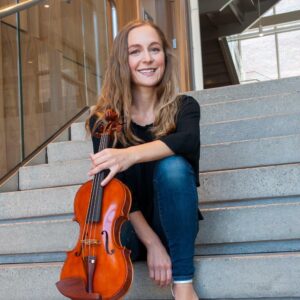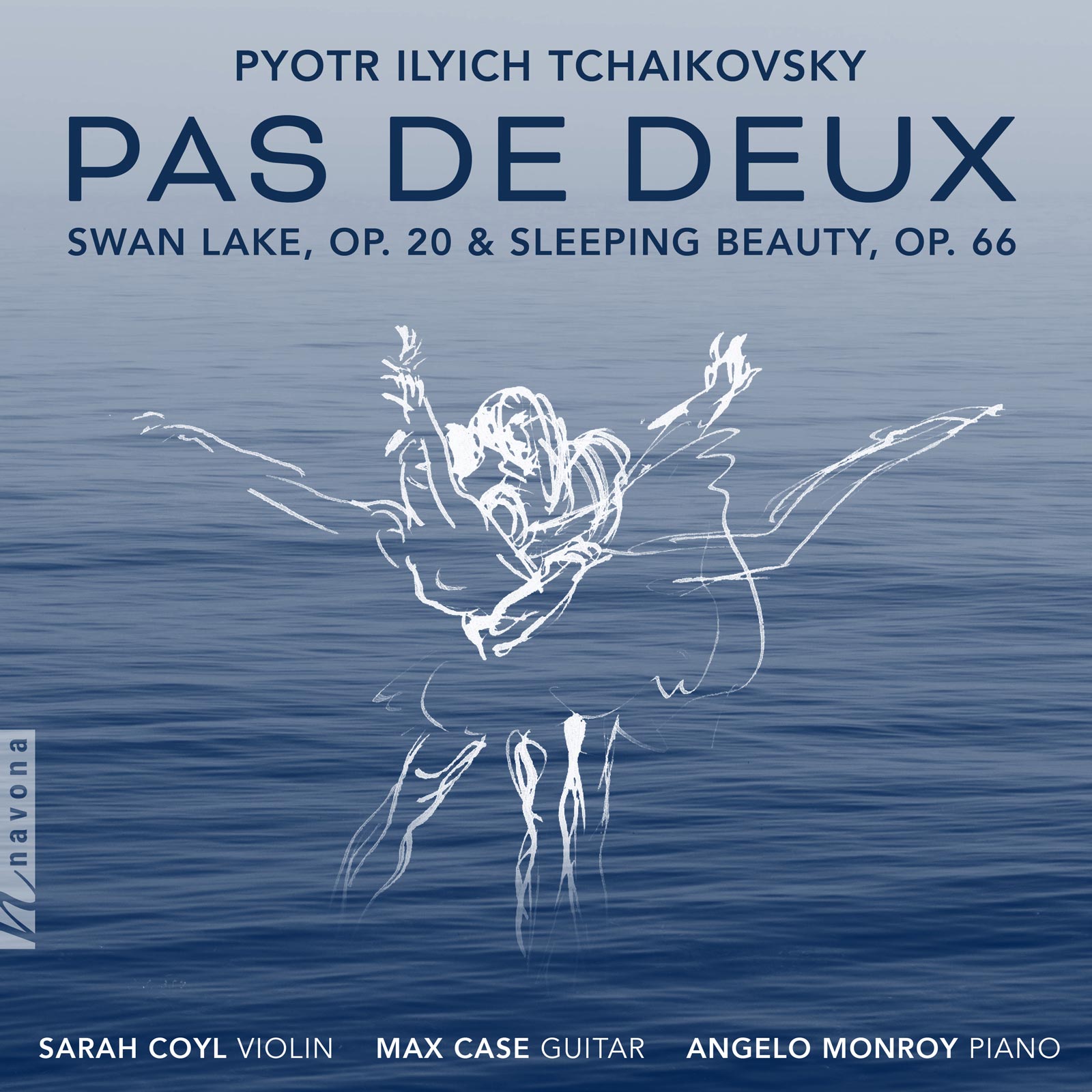Pas De Deux
Pyotr Ilyich Tchaikovsky composer
Sarah Coyl violin
Max Case guitar
Angelo Monroy piano
Tchaikovsky’s works burst with well-loved, well-known melodies – which is precisely what renders them a challenge for any young musician. How does one perform a cherished classic without resorting to cliché or to musical blasphemy? Talented violinist and arranger Sarah Coyl has found her personal answer to this dilemma on PAS DE DEUX: by re-setting the Russian composer’s works for unprecedented setups – in this case, the violin-guitar duo and the violin-guitar-piano trio.
This audacious endeavor is strengthened not only by Coyl’s undeniable talent as a multi-genre arranger, but also by her two skillful colleagues, the keen-minded, quick-fingered guitarist Max Case and emotive, empathetic pianist Angelo Monroy. The result is an album that is still very reverently Tchaikovsky – but seen from a fresher, more youthful angle.
Listen
Stream/Buy
Choose your platform
Track Listing & Credits
| # | Title | Composer | Performer | |
|---|---|---|---|---|
| 01 | Swan Lake, Op. 20: Act I, No. 5, Pas de deux: I. Tempo di valse ma non troppo vivo, quasi moderato | Pyotr Ilyich Tchaikovsky, arr. Sarah Coyl | Angelo Monroy, piano | 2:12 |
| 02 | Swan Lake, Op. 20: Act I, No. 5, Pas de deux: II. Andante - Allegro | Pyotr Ilyich Tchaikovsky, arr. Sarah Coyl | Sarah Coyl, violin; Max Case, acoustic guitar | 5:54 |
| 03 | Swan Lake, Op. 20: Act II, No. 13, Danses des cygnes: VI. Tempo di valse | Pyotr Ilyich Tchaikovsky, arr. Sarah Coyl | Sarah Coyl, violin; Max Case, acoustic guitar | 1:34 |
| 04 | Swan Lake, Op. 20: Act II, No. 13, Danses des cygnes: V. Andante - Allegro | Pyotr Ilyich Tchaikovsky, arr. Sarah Coyl | Sarah Coyl, violin; Max Case, acoustic guitar; Angelo Monroy, piano | 6:45 |
| 05 | Swan Lake, Op. 20: Act II, No. 13, Danses des cygnes: VI. Tempo di valse (reprise) | Pyotr Ilyich Tchaikovsky, arr. Sarah Coyl | Max Case, electric guitar; Angelo Monroy, piano | 1:52 |
| 06 | Sleeping Beauty, Op. 66: Act I, No.6, Valse | Pyotr Ilyich Tchaikovsky, arr. Sarah Coyl | Sarah Coyl, violin; Max Case, electric guitar; Angelo Monroy, piano | 6:00 |
| 07 | Sleeping Beauty, Op. 66: Act II, No. 15a, Pas d’action | Pyotr Ilyich Tchaikovsky, arr. Sarah Coyl | Sarah Coyl, viola, violin; Max Case, acoustic guitar | 5:19 |
| 08 | Sleeping Beauty, Op. 66: Act III, No. 28, Pas de deux: variation 2 (Aurora) | Pyotr Ilyich Tchaikovsky, arr. Sarah Coyl | Sarah Coyl, violin; Max Case, acoustic guitar | 1:49 |
Recorded June 2022 at Imirage Sound Lab in Sparks NV
Producer, Recorder & Mixer Tom Gordon, Inspired Amateur Productions
Engineer Thomas Beauchamp
Mastering Melanie Montgomery
Executive Producer Bob Lord
A&R Director Brandon MacNeil
A&R Chris Robinson
VP of Production Jan Košulič
Audio Director Lucas Paquette
VP, Design & Marketing Brett Picknell
Art Director Ryan Harrison
Design Edward A. Fleming, Morgan Hauber
Publicity Aidan Curran
Artist Information

Sarah Coyl
Heralded by Reno Arts News for her “tender” playing, Sarah Coyl enjoys a diverse musical career playing and teaching violin and viola. She is a member of the Reno Philharmonic Orchestra and an instructor of violin at the University of Nevada, Reno. As an emerging chamber musician, she has performed in concert on viola with world-renowned pianist Joyce Yang. Recent solo engagements include a performance of the Bruch Violin Concerto with the Tahoe Symphony Orchestra.
Max Case
At just 21 years old, guitarist Max Case is already commended for being “well-versed in many styles of music.” Case frequently performs with the Reno Jazz Orchestra as he completes his bachelor’s degree in Jazz Studies at the University of Nevada, Reno. He has performed with the Reno Philharmonic Orchestra, and his technical prowess and musicality keep him in high demand for collaborations with ensembles around Northern Nevada and California. Case recently performed a sold-out concert at the Reno Little Theater featuring his own arrangements of music by The Beatles. His musical background affords him a unique insight to playing chamber music, which he brings to his partnership with violinist Sarah Coyl.
Angelo Monroy
Angelo Monroy is a pianist, composer, and educator currently based in Reno NV. Capable in a wide variety of musical idioms, he has collaborated with the likes of Ralph Alessi, the Reno Philharmonic Orchestra, and has performed as a featured guest at the Jazz Education Network (JEN) Conference. His work was recently recognized by the First Lady of Nevada as part of a series highlighting BIPOC creatives, and is described as “having a fresh degree of reverence and humility.” Above all, he aims to help engage audiences and to break down socio-cultural barriers not only through his creative output, but also through his relentless pursuit of artistic and personal integrity.
Notes
A Pas de Deux is the apex dance of a ballet, in which the lead female and male dancers come together to show off their technical skill and expressive capabilities. When I was first given the opportunity to play in the pit orchestra with my university’s ballet company, I found myself completely enamored with the whole experience. The drama of Tchaikovsky’s Sleeping Beauty and the theatrical elements of the performance were things I had yet to encounter in my career. I appreciated the campiness and humor of ballet, something I realized I had been yearning for in my usual practice of serious symphonic works; I listened to recordings of the entire ballet on repeat well after the semester ended.
It was around the same time that I discovered my love for ballet that I also began arranging music. Though I was pursuing a degree in violin performance, I was going through a phase of burnout with classical music. Having played in jazz combos, when the time came to organize my recitals, I would program as little solo classical music as I could get away with. I would instead end up devoting all of my time and energy to arranging klezmer and tango tunes with parts for all of my friends.
Though grad school saw me becoming more serious about violin, I never lost my love for collaborating in styles outside of the classical realm. When COVID canceled all of my concerts, I started playing duos with talented jazz guitarist Max Case. We would occasionally read through repertoire such as Paganini’s sonatas, and I was fascinated by the way Max’s instincts as an improviser would sneak into the through-composed music we were reading. He offered a fresh perspective to the music I had become so burnt out on.
It was my frequent collaboration with Case that became the spark that inspired this project. Occasionally I would take a classical piece and turn it into a “chart,” with the chord changes written out over the melody; I oftentimes preferred his voice-leading choices over the composers’! In this process, I discovered that Tchakovsky’s harmonic writing uncannily resembles many jazz standards, and I consequently resolved to explore this relationship further.
While my original vision for the album was a simple showcase of selections from Sleeping Beauty and Swan Lake, the project began to morph into a concept album. Ballet music proved to be too grandiose for violin and acoustic guitar only; besides, it would be a shame not to highlight Case’s capabilities on electric guitar. Feeling that my initial draft of the iconic Waltz from Sleeping Beauty was trite, I decided to lean more heavily into the language of jazz, particularly in the vein of John Coltrane’s waltz style (a la My Favorite Things). I realized at that point I would need to employ the talents of my boyfriend and versatile pianist, Angelo Monroy, who along with the orchestral qualities of the piano, brought his skills as an improviser as well as his innate understanding of classical sensibilities.
This malleability and playfulness was exactly why I fell in love with ballet in the first place. The injection of new instruments and styles was what allowed me to weave my own narrative into the album; just as ballets are filled with humans transforming into swans and nutcrackers turning into princes, there was nothing holding me back from turning an acoustic guitar into an electric one, or transforming an intimate and weepy acoustic duet into a frenetic jazz waltz. Tchaikovsky’s music is so generous that its integrity remains intact regardless of what medium it’s played in; I feel grateful to have found my own voice in it.
– Sarah Coyl

